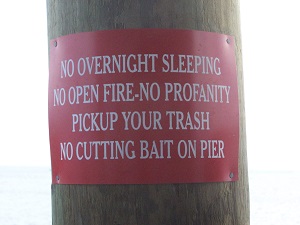In this day and age with bankruptcies on the rise, quite often this question comes up: are my retirement plan assets protected from a creditor? And of course, there are two ways you can take this – are the assets protected from a creditor of my employer; and are the assets protected from my personal creditors?

Photo credit: diedoe
Employer Creditors
Your vested qualified retirement plans (401(k), 403(b), etc.) are always protected from creditors, in the event that your company should declare bankruptcy. Vested retirement plans are your property (*upon distribution), not the property of the employer. The same is true for vested traditional qualified pension plans. However, with certain nonqualified retirement plans and non-vested plans or funds, there is a strong possibility that these assets could be accessed by your employer’s creditor in the event of a bankruptcy of the company.
The nonqualified plans are often called executive compensation, rabbi trust, deferred compensation, or supplemental retirement savings (among many other terms). The key here is that these accounts are “non-qualified”, and as such are not protected by the ERISA law. These accounts are very often open to access by creditors, so be aware of this if you’re a participant in such an account. Check with your HR department if you’re unsure if your retirement account(s) are qualified (and thus protected by ERISA) or not.
IRAs, being individual accounts totally separate from your employer (unless you’re self-employed) are not considered in any way to be assets of your employer. If you are self-employed and are not incorporated in some fashion, depending upon your state law, some of your IRA assets could be at risk, depending upon the state that you live in, and the balance of the account (see below).
Personal Creditors
In general, the Bankruptcy Abuse Prevention and Consumer Protection Act of 2005 (BAPCPA) provides that both traditional and Roth IRAs derived from contributions are protected from creditors up to $1 million. This protection only applies to bankruptcy, not to other judgments, and as such state law applies for all other situations. For example, your IRA is not protected against a judgment in the case of divorce, an IRS lien, or a criminal judgment against you. The level of creditor protection varies widely by state. For more up-to-date information on the protection within your state, click this link. Rollover (including trustee-to-trustee transfer) amounts from employer plans, SEP or SIMPLE IRAs maintain the original account’s ERISA protection from creditors.
There are cases, as illustrated recently in a case that was decided in 2007, where an inherited IRA with a revocable trust as the beneficiary became available to the decedent’s creditors. This case was in the state of Kansas, so other states may have differing laws, this was just an example. The way to resolve or avoid this is to use an irrevocable see-through trust as the beneficiary and use discretionary and spendthrift clauses within the trust as protection. Otherwise, naming an individual (or individuals) as the IRA beneficiary(s) would avoid this problem as well.
Further problems develop in the inherited IRA spectrum due to the fact that most state courts do not consider an inherited IRA to be a “retirement account”, since the owner (the beneficiary of the decedent) is currently receiving an income from the account. This is important because retirement accounts are specifically protected from creditors (due to BAPCPA).
Closing
Even though the IRA has somewhat fewer protections against creditors versus the employer plans, if you’ve left the employer this shouldn’t be the reason to leave funds in the old account. An IRA account can be considerably more flexible, easier to access, and (likely) lower in cost overall. Rolled-over funds maintain ERISA protection, as well.


 Sterling Raskie, MSFS, CFP®, ChFC®
Sterling Raskie, MSFS, CFP®, ChFC® The latest in our Owner’s Manual series, A 401(k) Owner’s Manual, was published in January 2020 and is available on
The latest in our Owner’s Manual series, A 401(k) Owner’s Manual, was published in January 2020 and is available on  A Medicare Owner’s Manual, is updated with 2020 facts and figures. This manual is available on
A Medicare Owner’s Manual, is updated with 2020 facts and figures. This manual is available on  Social Security for the Suddenly Single can be found on Amazon at
Social Security for the Suddenly Single can be found on Amazon at  Sterling’s first book, Lose Weight Save Money, can be
Sterling’s first book, Lose Weight Save Money, can be  An IRA Owner’s Manual, 2nd Edition is available for purchase on Amazon. Click the link to choose the
An IRA Owner’s Manual, 2nd Edition is available for purchase on Amazon. Click the link to choose the  Jim’s book – A Social Security Owner’s Manual, is now available on Amazon. Click this link for the
Jim’s book – A Social Security Owner’s Manual, is now available on Amazon. Click this link for the  And if you’ve come here to learn about queuing waterfowl, I apologize for the confusion. You may want to discuss your question with Lester, my loyal watchduck and self-proclaimed “advisor’s advisor”.
And if you’ve come here to learn about queuing waterfowl, I apologize for the confusion. You may want to discuss your question with Lester, my loyal watchduck and self-proclaimed “advisor’s advisor”.